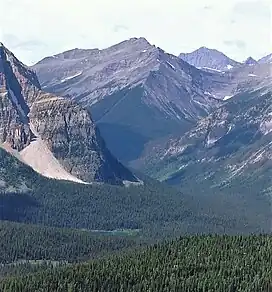| Mount Sam | |
|---|---|
 East-northeast aspect | |
| Highest point | |
| Elevation | 2,871 m (9,419 ft)[1][2] |
| Prominence | 443 m (1,453 ft)[3] |
| Parent peak | Octopus Mountain (2,932 m)[3] |
| Isolation | 2.25 km (1.40 mi)[3] |
| Listing | Mountains of British Columbia |
| Coordinates | 50°52′49″N 115°48′33″W / 50.88028°N 115.80917°W[4] |
| Naming | |
| Etymology | Peter M. Sam |
| Geography | |
 Mount Sam Location of Mount Sam in British Columbia  Mount Sam Mount Sam (Canada) | |
| Country | Canada |
| Province | British Columbia |
| District | Kootenay Land District[5] |
| Protected area | Mount Assiniboine Provincial Park |
| Parent range | Mitchell Range[3] Canadian Rockies |
| Topo map | NTS 82J13 Mount Assiniboine[4] |
| Geology | |
| Age of rock | Cambrian |
| Type of rock | Sedimentary rock |
Mount Sam is a 2,871-metre (9,419-foot) mountain summit located in Mount Assiniboine Provincial Park of British Columbia, Canada.
Description
Mount Sam is situated 12 km (7.5 mi) west of the Continental Divide and is part of the Mitchell Range which is a sub-range of the Canadian Rockies.[3] Precipitation runoff from the peak's east slope drains into the Mitchell River via Companion Creek and the west slope drains into Lachine Creek which is a tributary of the Simpson River. Topographic relief is modest as the summit rises 1,170 metres (3,839 ft) above Lachine Creek in 3 km (1.9 mi) and 1,200 metres (3,937 ft) above the Mitchell River in 4 km (2.5 mi).
Etymology
The mountain was named in remembrance of Army Private Peter Martin Sam, Royal Canadian Artillery, of Athalmer who was killed in action on April 21, 1941, age 20, during World War II.[2] The mountain's toponym was officially adopted on October 12, 1966, by the Geographical Names Board of Canada.[4]

Geology
Mount Sam is composed of sedimentary rock laid down during the Precambrian to Jurassic periods. Formed in shallow seas, this sedimentary rock was pushed east and over the top of younger rock during the Laramide orogeny.[6]
Climate
Based on the Köppen climate classification, Mount Sam is located in a subarctic climate zone with cold, snowy winters, and mild summers.[7] Winter temperatures can drop below −20 °C with wind chill factors below −30 °C.
See also
References
- ↑ Glen W. Boles, William Lowell Putnam, Roger W. Laurilla (2006), "Canadian Mountain Place Names", Rocky Mountain Books, ISBN 9781894765794, p. 220.
- 1 2 "Mount Sam". cdnrockiesdatabases.ca. Retrieved 2023-04-03.
- 1 2 3 4 5 "Mount Sam, Peakvisor.com". Retrieved 2023-04-03.
- 1 2 3 "Mount Sam". Geographical Names Data Base. Natural Resources Canada. Retrieved 2023-04-03.
- ↑ "Mount Sam". BC Geographical Names.
- ↑ Gadd, Ben (2008), Geology of the Rocky Mountains and Columbias
- ↑ Peel, M. C.; Finlayson, B. L.; McMahon, T. A. (2007). "Updated world map of the Köppen−Geiger climate classification". Hydrol. Earth Syst. Sci. 11: 1633–1644. ISSN 1027-5606.
External links
- Mount Sam: weather forecast
- Mount Assiniboine Provincial Park
- Peter Martin Sam: Canadian Virtual War Memorial